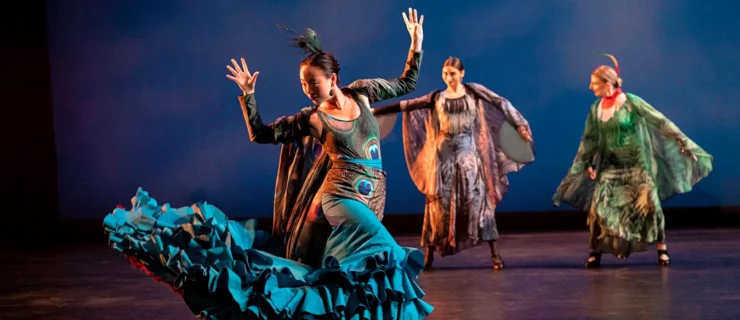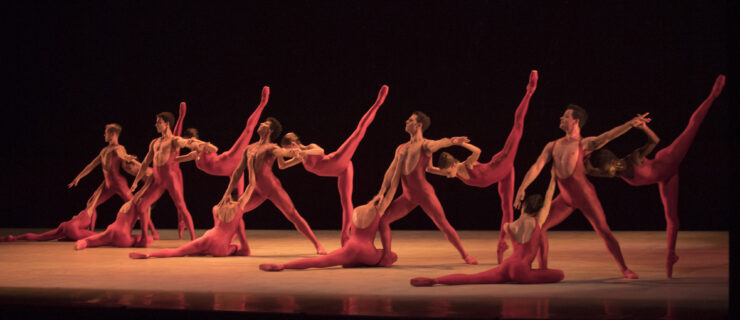Pina Bausch Tanztheater
Pina Bausch Tantztheater Wuppertal Nelken #6, choreography by Pina Bausch
Photo copyright by Ulli Weiss/courtesy UCLA Performing Arts
Royce Hall
University of california
Los Angeles, california
October 5-10, 1999
Reviewed by Donna Perlmutter
Mostly, it’s okay not to look for meaning in Pina Bausch’s 1982 dance work, Nelken (Carnations); taken on their own, the mirthful-to-bizarre-to-poignant-to-frightening scenes and images evoke highly personal associations that need no analysis.
On Peter Pabst’s set (a floor symmetrically embedded with several thousand pink and white silk carnations) parade a crowd of creatures: men rendered uneasy, innocent, and childlike in pale, gathered dresses that fit poorly?the backs hang open, too small to close. These men, along with the women, take guises first as youngsters, then as adults. They make hilarious mistakes, trying on different well-spoken expressions to counter their discomfort. Conversely, a mixed chorus assembles on a length of tabletops, then suddenly hunches over and lapses into an insouciant little unison dance on all fours to gently syncopated 1930s music. The sight, wholly enchanting, triggers an involuntary grin.
But there’s always an unwitting authority figure, Jan Minarik in his signature master-of-ceremonies/patriarch role. He stops the jackrabbiting, spanks an offender, asks for his passport, and, with microphone held to the chest) monitors various others’ racing heartbeats for all to hear. When he’s not around there are the uniformed security guards; at a moment of near-pandemonium their German shepherds start barking in rhythm to the music, and the scene devolves into tragicomedy. Perhaps subconsciously these are the next-generation Germans still calming their Nazi-horror demons (and learning to cry by dipping their faces in bowls of fresh-chopped onions).
Regardless, it’s the exquisite underside of experiences and feelings?in their original, unannotated version?that Bausch shows us; Nelken is a panorama of personae we all take on, set to music by Billie Holiday, Franz Lehar, and Schubert’s Death and the Maiden quartet, and, not least, “The Man I Love,” signed, spoken, and played.
None of it could transpire without Bausch’s aggregate of marvelously varied actor/dancers?who challenge each other in childhood games for grownups, as they do the audience. At one point Dominique Mercy defiantly gives the crowd what it always wants. “Chainés?” he asks, before snapping off a series. “Tours en l’air?” Voila!
Then Lutz F–rster complains, across the footlights: “You’re yawning and my feet are killing me!” just around the time the performers say goodbye to their child selves and don glamorous evening garb to look like the world-weary sophisticates that they are.
What we take away from this vastly entertaining extravaganza are snapshots of the universal humanizing/dehumanizing process.
For other views of Pina Bausch Tanztheater see reviews in January and February issues of Dance Magazine.




